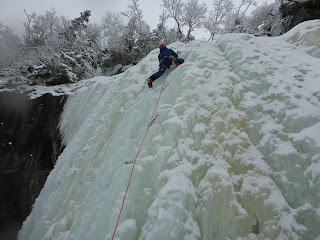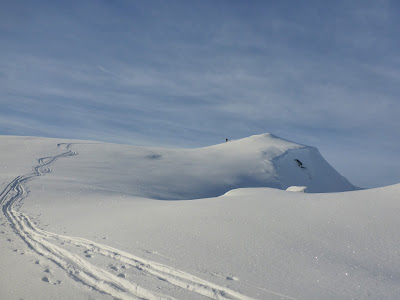The town of Rjuken in Southern Norway, is somewhere that I have wanted to visit for a while. It's international reputation for stable conditions that form quality ice lines in a concentrated area make it the subject of conversation amongst climbers around the world. I remember hearing stories of Rjuken in the Aberdeen climbing wall three years ago and in a Petzia in Chamonix last June. The opportunity to vist came in late febuary when myself and Sofia made the exciting 6 hour drive down from Sogndal to find out what all the fuss was about.
The very first sign that we were arriving somewhere special was when we came across a rental car stuck in deep snow with 5 french, Spanish and German climbers collecting branches and wishing that they had opted for rental insurance. After towing them out we had an exciting exchange of words about the area and the current ice conditions. Now this winter (2016,2017) has been a shocker for winter conditions across Europe (just ask my Scottish friends!). So after studying the slightly soggy forecast we were not surprised to be climbing rather soft ice when we arrived.
First off we visited Krokan for it's easily accessible single pitch routes. I recognised many of the climbed from pictures and videos but I didn't expect the place itself to be so beautiful.
its a pretty atmospheric place, with an astonishing variety of ice formation poring down into a river gorge. We climbed most of the obvious lines. And enjoyed meeting other climbers for the first time in a while.
Ruken itself provided more entertainment than we expected. The towns rich history can be discovered whilst exploring the local land marks: the statues of pioneering Norwegian hydro engineers pay trbute to the town historic role in the Industrial revolution in Norway.
 |
 |
| A Mirror has been erected upon the southern side of the valley, to eliminate the town centre for a few hours during he cold winter day. |
The Town that has relay embraced ice climbers and the old school house is the normal hostel hangout highly Recommended for climbers.
Ice climbing trips and low budgets don't normally coincided with comfort and convince but this particular small Norwegian town provided!
Need somewhere flat to park the van to sleep? no problem, you can park meters from creepy historical buildings and read about the Nazi scientists who once occupied them.
What about clean toilets and free local climbing guidebook loan- the public library provides!
Somwhere to dry your gloves? put them round the back of the radiator in one of the towns two public tanning salons open 8am until 11pm- what more could some climbing bums ask for?
In the evening we went looking for some longer routes on the outskirts of town. nice to watch the lights of Rjuken lighting up in the distance.
















































